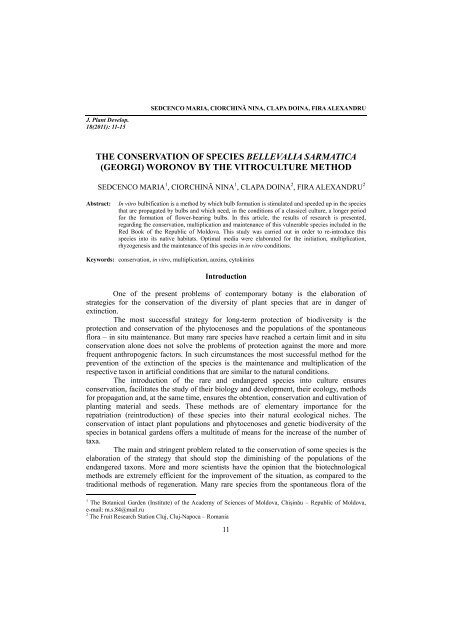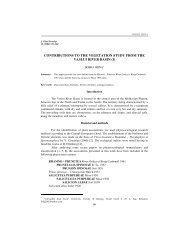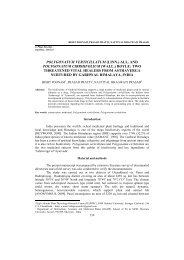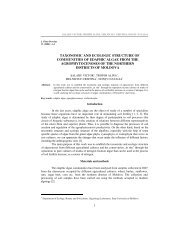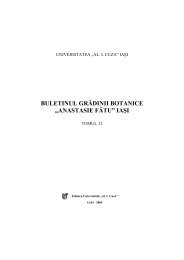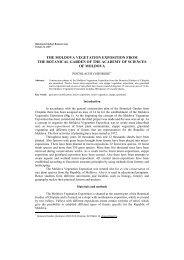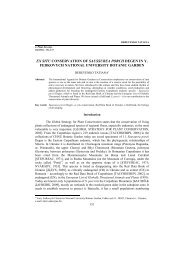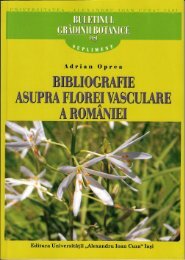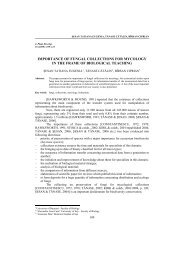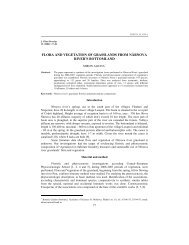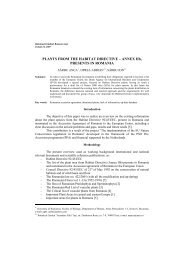the conservation of species bellevalia sarmatica - Journal of Plant ...
the conservation of species bellevalia sarmatica - Journal of Plant ...
the conservation of species bellevalia sarmatica - Journal of Plant ...
Create successful ePaper yourself
Turn your PDF publications into a flip-book with our unique Google optimized e-Paper software.
J. <strong>Plant</strong> Develop.<br />
18(2011): 11-15<br />
SEDCENCO MARIA, CIORCHINĂ NINA, CLAPA DOINA, FIRA ALEXANDRU<br />
THE CONSERVATION OF SPECIES BELLEVALIA SARMATICA<br />
(GEORGI) WORONOV BY THE VITROCULTURE METHOD<br />
SEDCENCO MARIA 1 , CIORCHINĂ NINA 1 , CLAPA DOINA 2 , FIRA ALEXANDRU 2<br />
Abstract: In vitro bulbification is a method by which bulb formation is stimulated and speeded up in <strong>the</strong> <strong>species</strong><br />
that are propagated by bulbs and which need, in <strong>the</strong> conditions <strong>of</strong> a classicel culture, a longer period<br />
for <strong>the</strong> formation <strong>of</strong> flower-bearing bulbs. In this article, <strong>the</strong> results <strong>of</strong> research is presented,<br />
regarding <strong>the</strong> <strong>conservation</strong>, multiplication and maintenance <strong>of</strong> this vulnerable <strong>species</strong> included in <strong>the</strong><br />
Red Book <strong>of</strong> <strong>the</strong> Republic <strong>of</strong> Moldova. This study was carried out in order to re-introduce this<br />
<strong>species</strong> into its native habitats. Optimal media were elaborated for <strong>the</strong> initiation, multiplication,<br />
rhyzogenesis and <strong>the</strong> maintenance <strong>of</strong> this <strong>species</strong> in in vitro conditions.<br />
Keywords: <strong>conservation</strong>, in vitro, multiplication, auxins, cytokinins<br />
Introduction<br />
One <strong>of</strong> <strong>the</strong> present problems <strong>of</strong> contemporary botany is <strong>the</strong> elaboration <strong>of</strong><br />
strategies for <strong>the</strong> <strong>conservation</strong> <strong>of</strong> <strong>the</strong> diversity <strong>of</strong> plant <strong>species</strong> that are in danger <strong>of</strong><br />
extinction.<br />
The most successful strategy for long-term protection <strong>of</strong> biodiversity is <strong>the</strong><br />
protection and <strong>conservation</strong> <strong>of</strong> <strong>the</strong> phytocenoses and <strong>the</strong> populations <strong>of</strong> <strong>the</strong> spontaneous<br />
flora – in situ maintenance. But many rare <strong>species</strong> have reached a certain limit and in situ<br />
<strong>conservation</strong> alone does not solve <strong>the</strong> problems <strong>of</strong> protection against <strong>the</strong> more and more<br />
frequent anthropogenic factors. In such circumstances <strong>the</strong> most successful method for <strong>the</strong><br />
prevention <strong>of</strong> <strong>the</strong> extinction <strong>of</strong> <strong>the</strong> <strong>species</strong> is <strong>the</strong> maintenance and multiplication <strong>of</strong> <strong>the</strong><br />
respective taxon in artificial conditions that are similar to <strong>the</strong> natural conditions.<br />
The introduction <strong>of</strong> <strong>the</strong> rare and endangered <strong>species</strong> into culture ensures<br />
<strong>conservation</strong>, facilitates <strong>the</strong> study <strong>of</strong> <strong>the</strong>ir biology and development, <strong>the</strong>ir ecology, methods<br />
for propagation and, at <strong>the</strong> same time, ensures <strong>the</strong> obtention, <strong>conservation</strong> and cultivation <strong>of</strong><br />
planting material and seeds. These methods are <strong>of</strong> elementary importance for <strong>the</strong><br />
repatriation (reintroduction) <strong>of</strong> <strong>the</strong>se <strong>species</strong> into <strong>the</strong>ir natural ecological niches. The<br />
<strong>conservation</strong> <strong>of</strong> intact plant populations and phytocenoses and genetic biodiversity <strong>of</strong> <strong>the</strong><br />
<strong>species</strong> in botanical gardens <strong>of</strong>fers a multitude <strong>of</strong> means for <strong>the</strong> increase <strong>of</strong> <strong>the</strong> number <strong>of</strong><br />
taxa.<br />
The main and stringent problem related to <strong>the</strong> <strong>conservation</strong> <strong>of</strong> some <strong>species</strong> is <strong>the</strong><br />
elaboration <strong>of</strong> <strong>the</strong> strategy that should stop <strong>the</strong> diminishing <strong>of</strong> <strong>the</strong> populations <strong>of</strong> <strong>the</strong><br />
endangered taxons. More and more scientists have <strong>the</strong> opinion that <strong>the</strong> biotechnological<br />
methods are extremely efficient for <strong>the</strong> improvement <strong>of</strong> <strong>the</strong> situation, as compared to <strong>the</strong><br />
traditional methods <strong>of</strong> regeneration. Many rare <strong>species</strong> from <strong>the</strong> spontaneous flora <strong>of</strong> <strong>the</strong><br />
1<br />
The Botanical Garden (Institute) <strong>of</strong> <strong>the</strong> Academy <strong>of</strong> Sciences <strong>of</strong> Moldova, Chişinău – Republic <strong>of</strong> Moldova,<br />
e-mail: m.s.84@mail.ru<br />
2<br />
The Fruit Research Station Cluj, Cluj-Napoca – Romania<br />
11
THE CONSERVATION OF SPECIES BELLEVALIA SARMATICA (GEORGI) WORONOV BY ...<br />
Republic <strong>of</strong> Moldova are continuously diminishing because <strong>of</strong> human activities that lead to<br />
<strong>the</strong> destruction <strong>of</strong> plant populations and <strong>the</strong> expansion <strong>of</strong> invasive <strong>species</strong>. Bellevalia<br />
<strong>sarmatica</strong> (Georgi) Woronov is a bulbous decorative <strong>species</strong> from <strong>the</strong> steppe included into<br />
<strong>the</strong> Red Book <strong>of</strong> <strong>the</strong> R. <strong>of</strong> Moldova, protected by <strong>the</strong> State [NEGRU, 2002]. Until recently,<br />
<strong>the</strong> steppe areas occupied 2/3 <strong>of</strong> <strong>the</strong> entire territory <strong>of</strong> Moldova. Presently, <strong>the</strong> natural<br />
steppe populations are maintained as some small territories as areas protected by <strong>the</strong> State<br />
[TELEUŢĂ, 2002].<br />
The use <strong>of</strong> in vitro cultures is in itself a <strong>conservation</strong> method, representing a viable<br />
and efficient alternative for <strong>the</strong> protection and maintenance <strong>of</strong> <strong>the</strong> genetic fund <strong>of</strong> rare and<br />
endangered <strong>species</strong>. In bulbous <strong>species</strong> <strong>the</strong> increased concentrations <strong>of</strong> sucrose lead to <strong>the</strong><br />
more rapid growth <strong>of</strong> <strong>the</strong> explants, such reducing <strong>the</strong> time necessary for <strong>the</strong> obtention <strong>of</strong><br />
bulbs and <strong>the</strong> period until <strong>the</strong> flowering phase [TAKUO & KOJI, 2004].<br />
The aim <strong>of</strong> <strong>the</strong> present study was <strong>the</strong> testing <strong>of</strong> <strong>the</strong> reaction in in vitro culture <strong>of</strong><br />
<strong>the</strong> explants prelevated from a mature Bellevalia <strong>sarmatica</strong> plant in order to initiate tissue<br />
cultures for <strong>the</strong> medium-term <strong>conservation</strong> <strong>of</strong> this <strong>species</strong> and <strong>the</strong> induction <strong>of</strong> <strong>the</strong><br />
regeneration process for <strong>the</strong> obtention <strong>of</strong> viable plants.<br />
Material and methods<br />
The material used for in vitro culture consisted <strong>of</strong> flower-bearing bulb explants<br />
taken from mature Bellevalia <strong>sarmatica</strong> plants that were collected in <strong>the</strong> Budjac<br />
Reservation in June 2010.<br />
One <strong>of</strong> <strong>the</strong> main conditions for successful microcloning is <strong>the</strong> sterilization <strong>of</strong> <strong>the</strong><br />
explant [CAVALLINI & al. 1987]. The explants prelevated from <strong>the</strong> donor material (bulb,<br />
bulb fragments) were washed under running tap water for 15 minutes. The pre-sterilization<br />
was carried aut in a solution <strong>of</strong> KMnO4 (0.05%) + Tween-20 for 10 minutes. Sterilization<br />
was done with diacid (0.01%) solution for 6-7 minutes, followed by 3 rinses with sterile<br />
distilled water. After <strong>the</strong> disinfection <strong>of</strong> plant material, <strong>the</strong> explants were inoculated on <strong>the</strong><br />
culture media, in large or small flasks depending on <strong>the</strong> size <strong>of</strong> <strong>the</strong> prelevated fragments, so<br />
as <strong>the</strong> newly formed bulbs should have enough space for development.<br />
For <strong>the</strong> study <strong>of</strong> <strong>the</strong> reactivity <strong>of</strong> this <strong>species</strong> in in vitro culture, several variants <strong>of</strong><br />
culture media were tested, all <strong>of</strong> <strong>the</strong>m with <strong>the</strong> macro- and microelements according to <strong>the</strong><br />
MS [MURASHIGE & SCOOG, 1962] formula, presented in Tab. 1.<br />
The introduction into in vitro culture was done in nutritive media with various<br />
concentrations <strong>of</strong> plant hormones. For <strong>the</strong> initiation <strong>of</strong> in vitro cultures, media with low<br />
concentrations <strong>of</strong> auxins and cytokinins were tested (variants B-1, B-2, B-3). For rapid bulb<br />
development and root formation two variants <strong>of</strong> media were tested (B-6, B-9). As carbon<br />
source, sucrose was used. All <strong>the</strong> culture media were gelled with 6 g/l agar. The pH <strong>of</strong> <strong>the</strong><br />
media was adjusted to 5.8 before autoclavation.<br />
Results and discussions<br />
The first evident observations were done after 4 weeks, when it was found that a<br />
large number <strong>of</strong> explants generated small protuberances, similar to 0.5 mm bulbils.<br />
The testing <strong>of</strong> <strong>the</strong> three variants <strong>of</strong> media for culture initiation (Tab. 1)<br />
evidentiated <strong>the</strong> fact that <strong>the</strong> optimal medium for this phase was <strong>the</strong> one that contained MS<br />
(1962) macro- and microelements as basal medium and 1.0 mg/l–6-benzylamilopurine<br />
12
SEDCENCO MARIA, CIORCHINĂ NINA, CLAPA DOINA, FIRA ALEXANDRU<br />
(BAP) and 0.25 mg/l - α-naphtylacetic acid (NAA) and 30 g/l sucrose (B-1). After 6 weeks<br />
<strong>of</strong> culture, 10-12 bulbs/explant were obtained, with a diameter <strong>of</strong> about 3.0 mm (Fig. 1, a).<br />
On <strong>the</strong> B-2 medium, with a lower BAP concentration (0.5 mg/l) feweer bulbs fewer bulbs<br />
were formed (7-9 bulbs/explant). Regeneration also took place on <strong>the</strong> medium with Kinetin<br />
(B-3), but in a lower percentage (4-6 bulbils/explant). The first de novo regenerated bulbils<br />
on this medium were noticed after 8 weeks in culture. This fact demonstrates that <strong>the</strong><br />
presence <strong>of</strong> BAP leads to a better growth <strong>of</strong> isolated tissues and better organogenesis as<br />
compared to <strong>the</strong> variants with Kinetin [VOINOV & al. 2009]<br />
The bulbs obtained were transferred onto culture media with higher concentrations<br />
<strong>of</strong> plant hormones and sucrose. On <strong>the</strong> media with increased concentration <strong>of</strong> sucrose a<br />
more rapid growth <strong>of</strong> bulbils was observed and <strong>the</strong>re <strong>the</strong> bulbs had <strong>the</strong> largest diameters, <strong>of</strong><br />
14-17 mm. After two weeks <strong>of</strong> culture on B-6, B-9 media <strong>the</strong> bulbs formed roots and<br />
leaves. Between <strong>the</strong> two variants <strong>of</strong> media, B-6 and B-9 <strong>the</strong>re were no significant<br />
differences regarding growth and organogenesis, so that for this stage <strong>the</strong> B-6 medium with<br />
60 g/l sucrose can be recommended (Fig. 1, b).<br />
The bulbs that were regenerated in vitro were acclimated ex vitro and successfully<br />
transferred to ex vitro conditions. Acclimatization was carried aut in conditions <strong>of</strong><br />
controlled climate regarding humidity and temperature, in peat and perlite mixture, for 14<br />
days. The survival rate was <strong>of</strong> 100% and plant growth and development continued.<br />
The results obtained in this <strong>species</strong> are promising, so <strong>the</strong> method <strong>of</strong> vitrocultures<br />
will be extended for o<strong>the</strong>r important and endangered taxons from <strong>the</strong> spontaneous flora,<br />
which is constantly diminishing and necessitates protection.<br />
Conclusions<br />
On <strong>the</strong> basis <strong>of</strong> our research we can conclude that:<br />
For <strong>the</strong> sterilization <strong>of</strong> plant material (bulbs) for <strong>the</strong> initiation <strong>of</strong> in vitro culture <strong>of</strong><br />
<strong>species</strong> Bellevalia <strong>sarmatica</strong> (Georgi) Woronow it is recommended to use disinfection with<br />
KMnO4 (0.05%) + Tween-20 for 10 minutes and diacid (0.01%) solution for 6-7 minutes.<br />
On <strong>the</strong> basal MS medium supplemented with BАP and NAA at <strong>the</strong> concentrations<br />
<strong>of</strong> 1.0 mg/l and respectively 0.25 mg/l <strong>the</strong> best results were obtained regarding <strong>the</strong><br />
efficiency <strong>of</strong> microcloning and morphogenic potential.<br />
The optimal medium for rhyzogenesis and rapid growth was MS basal medium<br />
supplemented with BАP (1.0 mg/l), NAA (1.0 mg/l) and sucrose at <strong>the</strong> concentration <strong>of</strong> 60 g/l.<br />
For <strong>the</strong> acclimation <strong>of</strong> bulbs <strong>the</strong> optimal conditions were found and <strong>the</strong> time for<br />
flower-bearing bulb formation was reduced with 1-2 years.<br />
The protocol for micropropagation and medium-term maintenance in in vitro culture<br />
can be successfully used for <strong>the</strong> <strong>conservation</strong> <strong>of</strong> <strong>the</strong> endangered <strong>species</strong> Bellevalia <strong>sarmatica</strong><br />
(Georgi) Woronow. Applying this method ensures <strong>the</strong> possibility <strong>of</strong> obtaining homogenous<br />
planting material in large amounts in a short period <strong>of</strong> time and in limited space.<br />
Acknowledgements<br />
This work was supported by ANCS Romania, project number 425/2010, Bilateral<br />
Cooperations.<br />
13
THE CONSERVATION OF SPECIES BELLEVALIA SARMATICA (GEORGI) WORONOV BY ...<br />
References<br />
1. NEGRU A., ŞABANOV G. & al. 2002. <strong>Plant</strong>ele rare din flora spontana a Republicii Moldova. CE USM,<br />
Chişinău.<br />
2. TELEUŢĂ A. 2002. Strategia Naţională şi planul de acţiune în domeniul conservării diversităţii biologice,<br />
Republica Moldova Chişinău.<br />
3. TAKUO F. & KOJI N. 2004. Rapid Production <strong>of</strong> Lilium auratum Bulbs from Zygotic Embryos. Asia Pacific<br />
<strong>Journal</strong> <strong>of</strong> Molecular Biology and Biotechnology, 12: 39-42.<br />
4. Н. А. ВОЙНОВ, Т. Г. ВОЛОВА и др. 2009. Современные проблемы и методы биотехнологии.<br />
Красноярск ИПК СФУ, Стр. 415 pp.<br />
5. CAVALLINI A., LUPI M. C., CREMONINI R. & BENNICI A. 1987. In vitro culture <strong>of</strong> Bellevalia romana<br />
(L.) Rchb. Protoplasma: 66-70.<br />
6. MURASHIGE T. & SCOOG. F. 1962. A revised medium for rapid growth and bioassays with tobacco tissue<br />
culture. Physiol. <strong>Plant</strong>, 15: 473-497.<br />
14
SEDCENCO MARIA, CIORCHINĂ NINA, CLAPA DOINA, FIRA ALEXANDRU<br />
Tab. 1. The composition <strong>of</strong> <strong>the</strong> nutritive media for <strong>the</strong> microclonal propagation <strong>of</strong> <strong>species</strong><br />
Bellevalia <strong>sarmatica</strong><br />
Media for culture<br />
initiation<br />
Media for rapid<br />
development<br />
Variants Basal medium Supplementary additives<br />
B-1 МS-100%<br />
B-2 МS-100%<br />
B-3 МS-100%<br />
B-6 МS-100%<br />
B-9 МS-100%<br />
15<br />
1.0 mg/l BAP<br />
0.25mg/l NAA<br />
30 g/l sucrose<br />
0.5 mg/l BAP<br />
0.25 mg/l NAA<br />
30 g/l sucrose<br />
0.5 mg/l kinetin<br />
0.25 mg/l IAA<br />
30 g/l sucrose<br />
1.0 mg/l BAP<br />
1.0 mg/l NAA<br />
60 g/l sucrose<br />
1.0 mg/l BAP<br />
1.0 mg/l NAA<br />
90 g/l sucrose<br />
Fig. 1. The in vitro culture <strong>of</strong> <strong>species</strong> Bellevalia <strong>sarmatica</strong> on B-1 medium (a) and B-6 medium (b)


